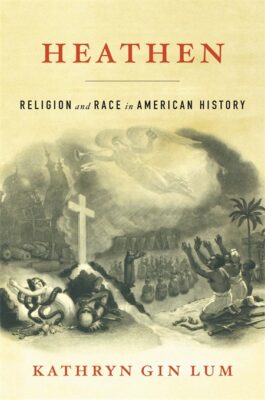 We are honored to announce that the 2023 S-USIH Annual Book Prize has been awarded to Kathryn Gin Lum (Stanford University) for Heathen: Religion and Race in American History (Harvard University Press, 2022). Huzzah and congrats!
We are honored to announce that the 2023 S-USIH Annual Book Prize has been awarded to Kathryn Gin Lum (Stanford University) for Heathen: Religion and Race in American History (Harvard University Press, 2022). Huzzah and congrats!
Award winners receive a $250.00 prize and their work is recognized at an upcoming S-USIH annual conference. The 2023 S-USIH Book Award is given for the best academic book in U.S. intellectual history published in English in the period between Jan. 1, 2022 and Dec. 31, 2022.
You can learn about past prize winners and their scholarship in our Spotlight/Insight interview series. Stay tuned for our #USIH2023 conference program, coming soon, which will feature a special related roundtable at the Presidents’ Lunch. Meanwhile, you can enjoy the USIH review of Gin Lum’s work here.
We are incredibly grateful to the 2023 S-USIH Annual Book Prize committee of Sarah E. Gardner (Chair), Angus Burgin, and Jordan Watkins for their hard work. Here is the committee’s statement on Kathryn Gin Lum’s prize-winning scholarship:
“We are delighted to announce Kathryn Gin Lum, author of Heathen: Religion and Race in American History, as the recipient of the 2023 S-USIH Annual Book Prize. In her expansive and ambitious study, Gin Lum challenges the replacement narrative, which long associated the category of the heathen with a binary conception of religious difference that was displaced over time by racial hierarchies. Ranging widely across sources from the sixteenth century to the rise of the internet, she unravels a more complicated story, showing how the idea of the “heathen” was often mobilized both to racialize those associated with it and to demarcate the boundaries of Whiteness and White Protestantism.
In this narrative, religion making and racial othering are co-constitutive. Gin Lum powerfully demonstrates that even as White Protestant Americans presented themselves as the self-appointed teachers of the heathen, they often approached the genuineness of conversions with skepticism and suspicion: the idea of heathenism as a familial identity passed down through generations could make it extraordinarily difficult to escape the label. The book emphasizes that such invocations were not unidirectional, however. Instead, it shows how those labeled with the term sometimes reappropriated it as a weapon, turning it on their oppressors as a tool to uncover and expose their hypocrisies. Native Americans, Black Americans, Hawaiians, Chinese Immigrants, and others variously used the elastic category for their own purposes. While attentive to change, Gin Lum emphasizes continuity.
In tracking how explicit invocations of the religio-racist heathen concept declined, Gin Lum argues that related patterns of thinking persisted in discourses centered on the modernization of “developing countries” and the “Third World.” Gin Lum’s provocative narrative reorients our temporal mappings by asking us to recognize the deep (religious) roots of racial othering and the enduring (racial) power of a religiously rooted concept. The committee was especially impressed by the range and heterogeneity of Gin Lum’s subjects, as well as her creative use of imagery and landscape as objects of analysis. Gin Lum’s attention to various peoples and places yields an account of race and racism that includes but also extends beyond White and Black. In a year with many excellent submissions, Heathen stood out for both the originality of its methods and for the enduring significance of its argument.”

0